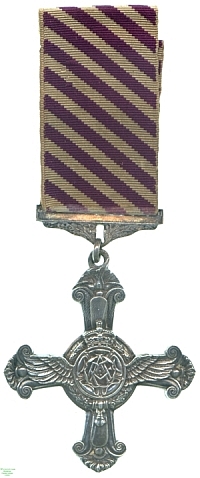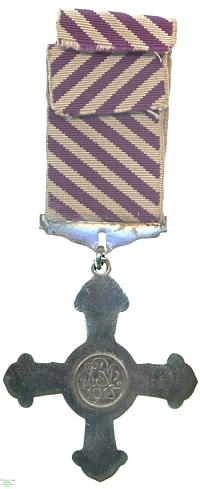Distinguished Flying Cross, awarded to 2nd Lt. John Mitchell 1920

Obverse, the RAF monogram in a central rosette both winged and tailed, and surmounted by a crown, the whole with a wreathed border and set on a two-bladed airscrew, it and the wings protruding into the arms of the cross, all of which is tipped with floral ornament
|

Reverse, a monogrammatic inscription in a central border
|
<- Previous | Next ->
Back to gallery page
Distinguished Flying Cross, 1920 (South Russian Campaign)
The DFC was instituted in June 1918, on the combination of the Army's Royal Flying Corps and the Navy's Royal Naval Air Service into the new Royal Air Force. It was to reward officers and warrant officers of the new Service for acts of valour while flying in active operations against the enemy. In 1993, with the discontinuation of the Distinguished Flying Medal, the DFC was made available to all ranks in the RAF and is still on current issue.
This medal is unnamed, but belonged to 2nd Lieutenant John Mitchell of the Royal Air Force, with whose other medals Lester Watson acquired it. The bulk of these decorations were earnt in service in the 1919-1920 campaigns in South Russia, and it was also there that he earned the DFC. In fact Mitchell and his pilot were recommended for the Victoria Cross, but in the confusions of evacuation from the South Russian campaign substantiating statements could not be obtained. General Maunde wrote (in a letter to the British Military Mission, South Russia, 6 February 1920) of the exploit for which Mitchell earned this medal:
"For most conspicuous gallantry and self-sacrificing devotion to duty. On July 30th, 1919, near Cherni Yar on the river Volga, Lieutenant Mitchell was observer on a D.H.9 machine of `C' Flight, 47th Squadron. The petrol tank of the machine was holed by a bullet from the ground. Lieutenant Mitchell climbed out on to the port plane and closed the holes with his thumbs. He continued to do so whilst his pilot, Captain W. F. Anderson, RAF, landed to pick up the crew of another machine which had been brought down by machine gun fire, five miles behind the enemy's most advanced troops. The pilot and observer of the wrecked machine were picked up and rescued. Lieutenant Mitchell's outstanding gallantry and endurance made it possible for his pilot to continue flying and resulted in the saving of the lives of two of his comrades. He was fifty minutes on the plane, and at the machine landing at the aerodrome was so exhausted by burns from the exhaust and from the air pressure that he had to be sent to hospital.
"He has since been wounded while carrying out a daring raid on hostile craft on the river Volga."
It was for this latter action that Mitchell was made a member of the Russian Order of Saint George and probably also earnt his DSO. Mitchell's award of the DFC was recorded in the London Gazette for 12 July 1920 and he was mentioned in Dispatches on 16 July.
Mitchell's wing-walking exploit finds an eerie parallel in the heroism of another Watson Collection medal's recipient! Although the catalogue of the Watson Collection considers this medal part of its Group 7, the medals of that group are not physically attached and so have been treated separately here. Nonetheless it was as a group that Lester Watson purchased them, from the London dealers Baldwin in 1928.

